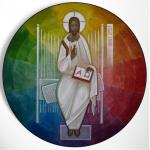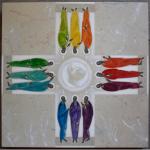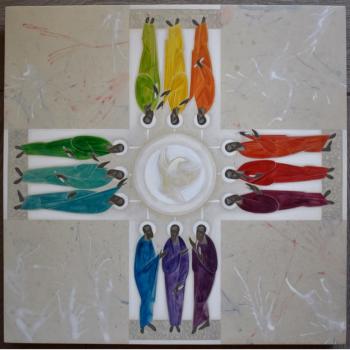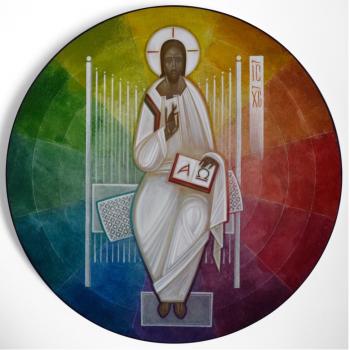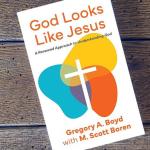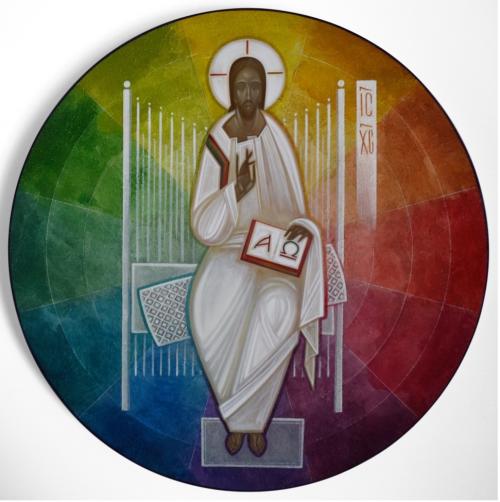
Visionings is a series that explores sight and seeing.
A Recap
In the last piece, I offered a general introduction to icons. This will be a more practical guide to praying with icons. The next will highlight the work of a current iconographer, Khrystyna Kvyk, whose work I’ve come to know and appreciate over the past year. The image above is her icon “I am the light of the world.”
As we learn how to pray through icons, I want to keep before our eyes the working definition of icons:
An icon is an image you look through to behold the beauty of the Lord. They are portals that, when contemplated with the eyes of faith, open the seer into communion with God.
Beyond their gravitational beauty, the reason I am interested in icons is because of the central place they play in the spirituality of the Eastern Church. For so many Christians over the centuries, icons have been central to communion with God, which is the heartbeat of discipleship.
Personal Knowledge
Discipleship – being an apprentice to the Lord Jesus – is less about gaining theoretical knowledge and more about growing in practical skills (i.e., love). Better yet: this apprenticeship is about growing in what Michael Polyani calls “personal knowledge.” According to Polanyi, all knowing is personal; objectivity is a modern myth. Knowing is an art that requires personal commitment and experience: a kind of contact with reality. Knowledge is transferred and picked up from person to person by experience, oftentimes through gaining practical expertise with tools. You can “know” how to ride a bike by watching a YouTube tutorial. Whether you really know how to ride a bike will quickly become apparent when you hop in the saddle.
What does this have to do with icons?
All this means that the worst way to learn to pray is to read a book about prayer (or a blog post!). The best way to learn to pray is by praying, following in the footsteps of faithful guides. It is caught more than taught. To know how to pray requires learning through personal experience. Hopefully this post (and the other recommended resources) will help you become fluent in the language of icons and the language from which it is derived, which is prayer.
A process for praying through icons
I’ve attempted to distill the process into steps. But this is artificial. Learning to pray is more like developing the art of conversation with a close friend than it is following a step-by-step guide for building an IKEA shelf. Nevertheless, you’ll need to have two things: quiet and an icon. You’ll then need to do two things: gaze and pray.
1. QUIET
The greatest obstacle to prayer is noise. The key to prayer is attention. To enter into prayer – with or without an icon – requires quiet. The first step to praying through icons is finding (or more likely creating) a quiet, comfortable space, free of distraction. Such a space offers the greatest potential for paying attention to God, which is what prayer is.
2. ICON
Ideally this will be a physical object (not image viewed on a screen). Not that screens are bad but they are sources of distraction. Plus, using a physical icon reminds us that we are embodied, physical beings. Our bodies matter. We pray with our bodies.
As you’ll see, icons can appear strange, especially for us in the west. The perspective and forms are alien to us. Partly this is because we’re unfamiliar with this kind of art. Partly this is because icons are not meant to be “realistic.” They are crafted following traditional rules transferred from master to apprentice, generation by generation down through the centuries. The aim is not towards realism, but towards prayer. We’ll look at this in more detail in the next post.
For now, it’s enough to know that icons are a kind of spiritual-abstract art with a liturgical subject. The perspective, forms, content, and even colors speak in a venerable language that invites communication and communion with God. Unfamiliarity with the style may initially lead to distraction but they are intentionally painted in such a way to avoid distraction and facilitate prayer.
3. GAZE
When we gaze at an icon, we aim to devote our complete attention to God. Collecting your attention and focusing it is a challenge. It is perhaps the greatest challenge and most difficult and valuable skill we can develop as human beings. If nothing else, gazing at icons helps in developing this most important skill.
In his wonderful little book Behold the Beauty of the Lord, Henri Nouwen describes why icons are not easy to “see.” He writes:
They do not immediately speak to our senses. They do not excite, fascinate, stir our emotions, or stimulate our imagination. At first, they even seem somewhat rigid, lifeless, schematic, and dull. They do not reveal themselves to us at first sight. It is only gradually, after patient, prayerful presence that they start speaking to us. And as they speak, they speak more to our inner than to our outer senses. They speak to the heart that searches for God.
If the icon is inspired by a biblical scene, it can be helpful to meditate on the biblical text. The interaction between the Scripture and the icon can be very dynamic. Learning more about the language of iconography – the meaning of subjects, symbols, and forms will also enrich the quality of your gaze (resources for this are listed below).
As you gaze. Pay attention. Ask: What do I notice? What do I see? What emerges? Where is there resonance? Dissonance? Do I sense any invitation?
4. PRAY
Henri Nouwen describes this transition into communion with the Lord as our gaze gradually becoming prayer. This is helpful language. Like how learning scales eventually becomes jazz, learning to pray through icons is an art whose freedom is learned in time by discipline and repetition. There are no shortcuts.
As your gaze becomes prayer, it can be helpful see the icon as a liminal object. “Liminal” comes from the Latin meaning “a threshold.” As in architecture, liminality refers to a space that is passageway between one place and another. Icons are thin objects that lead to thick places. They are portals that, when contemplated with the eyes of faith, open the seer into communion with God.
In this sense, icons are windows. You can look at a window and you can look through a window. When the gaze becomes prayer, the icon is transfigured from an object looked at to one looked through, ultimately to the Living God.
As you pray, it is important to remember that this is less about the content of the icon and more about communion with God. It’s really not about following steps. It’s a conversation. We are listening, responding, asking, answering. Prayer is a kind of seeing and also a kind of being seen. Praying through icons is an improvisational attending to and in the Holy Spirit.
Go and do likewise
This is really just a primer for praying with icons. Don’t just read this – try to put this into practice. Find an icon. Familiarize yourself with this process of praying through icons and go for it. Practice entering into the presence of God.
I’d love to hear about your experience… or any other resources you’ve found useful.
Resources for going deeper
The more familiar you become with icons and their unique language, the richer and deeper will be your gaze and prayer. Here are some guides that I’ve found valuable
Buy Icons from The monks of St. Isaac of Syria Skete . They offer high-quality, affordable reproductions.
Henri Nouwen, Behold the Beauty of the Lord: Praying with Icons. If you’re going to get one thing, get this book. It’s short and inexpensive. Nouwen leads you through his experiences praying with four classic icons. Follow in his footsteps.
Leonid Ouspensky, The Meaning of Icons. This is probably the most valuable resource for praying through icons but it’s expensive. This is more for the person who really wants to pick up this spiritual practice and devote themselves more seriously to it.
Jim Forest, Praying with Icons. This is another fine introduction to icons and how to pray through them. A bit more comprehensive than Nouwen (but the gold of Nouwen is its shortness).
Rowan Williams, The Dwelling of the Light: Praying with Icons of Christ. In this little volume, the former Archbishop of Canterbury guides the reader through praying through icons of Christ. Anything by Acbp. Williams is worth a read.

